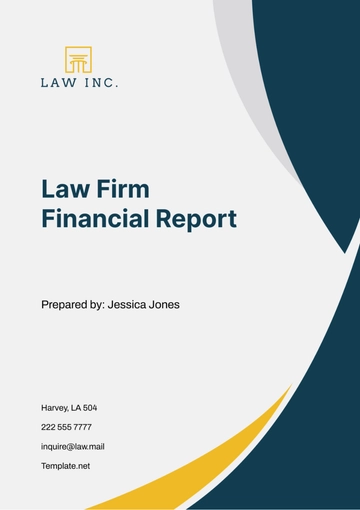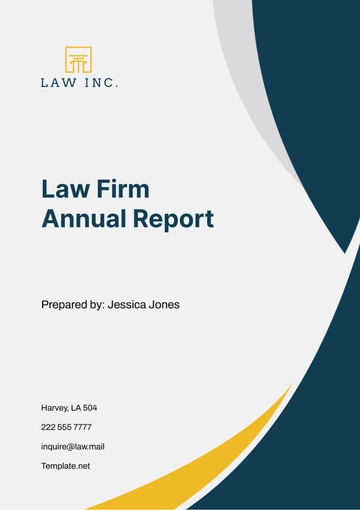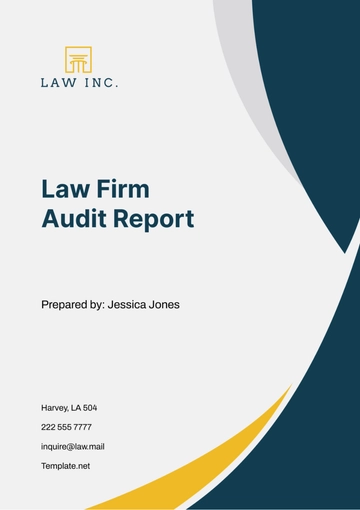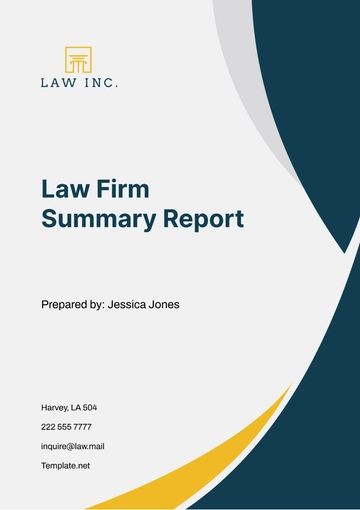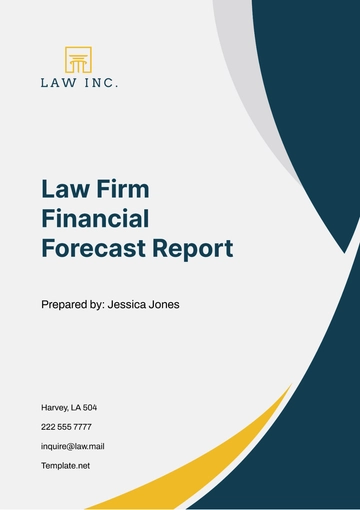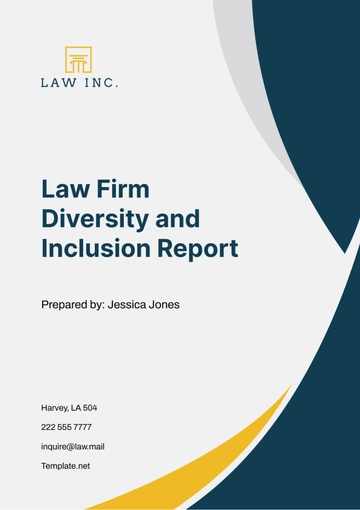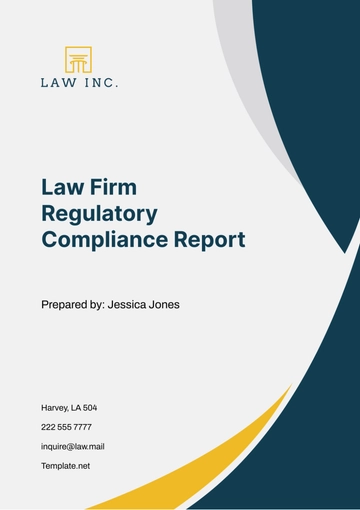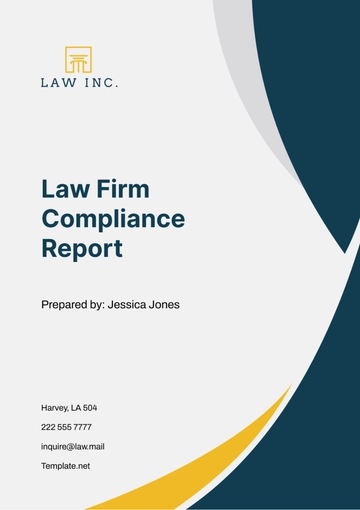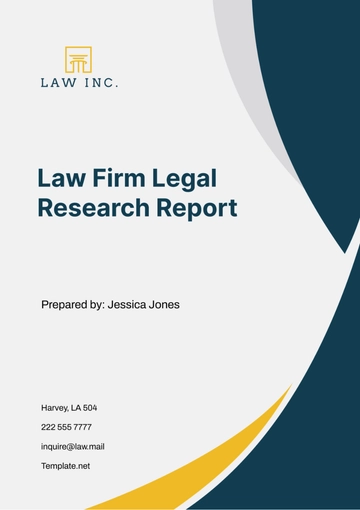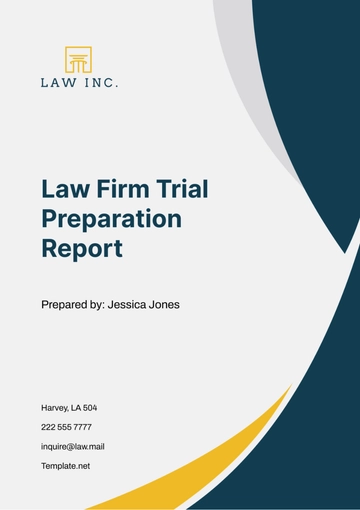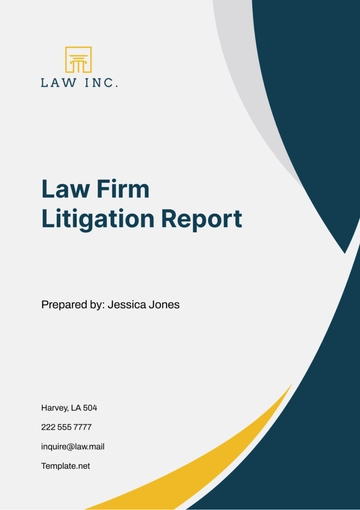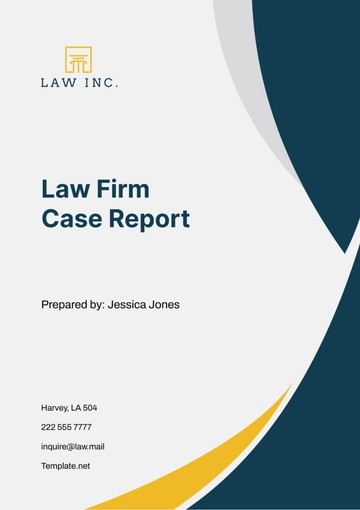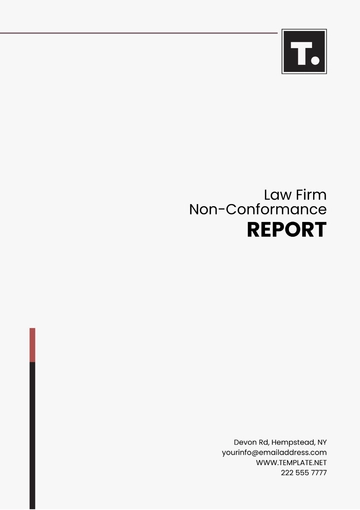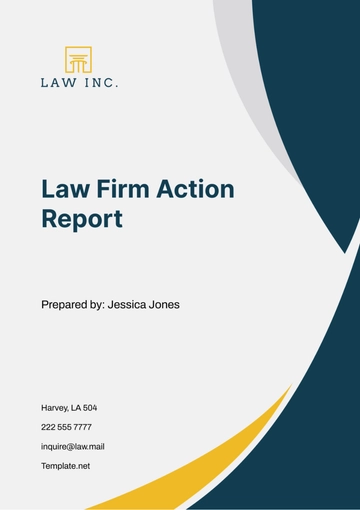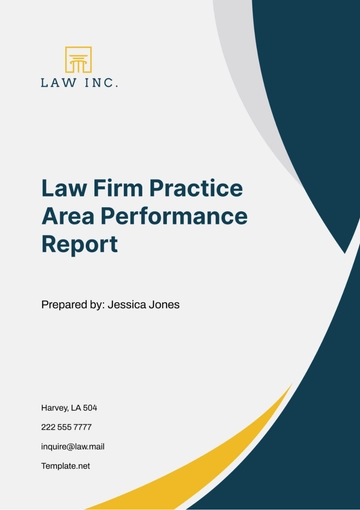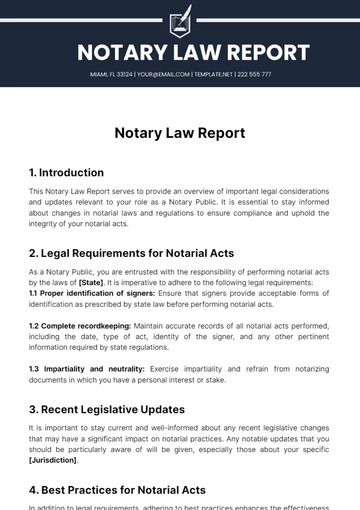Free Law Firm Financial Forecast Report

I. Executive Summary
This Financial Forecast Report for [Your Company Name] offers a strategic and detailed analysis of our financial trajectory, market positioning, and potential risks. This report is a crucial tool that aids in our decision-making process, helping us to navigate the complexities of the legal industry effectively.
The report begins with an overview of our financial projections, which predict a steady growth in both revenue and net income over the next three years. This positive outlook is a testament to the robustness of our business strategies and our commitment to delivering high-quality legal services. However, we also anticipate an increase in expenses, emphasizing the importance of effective cost management in maintaining our profitability.
Key financial highlights include our strong market position, as evidenced by our competitive analysis, and our proactive approach to risk management. The report also identifies several market trends that present both opportunities and challenges for [Your Company Name]. By staying abreast of these trends and adapting our strategies accordingly, we aim to ensure our continued success in the ever-evolving legal landscape.
II. Market Analysis
A. Industry Overview
At [Your Company Name], we understand the importance of staying abreast with the current state of the legal industry. This not only helps us to adapt and evolve, but also to strategize and plan for the future. The following table provides a snapshot of key aspects of the legal industry for the years 2051 to 2053:
Year | Market Size | Growth Rate |
|---|---|---|
2051 | $1,200,000,000 | 3.5% |
2052 | $1,300,000,000 | 4.0% |
2053 | $1,400,000,000 | 4.5% |
The data in the table provides valuable insights into the legal industry. In 2051, the market size was $1,200,000,000 and the growth rate was 3.5%. This suggests that 2051 was a year of significant growth in the legal industry.
In 2052, the market size increased to $1,300,000,000 and the growth rate rose to 4.0%. This indicates that 2052 was a year of continued growth, with the legal industry expanding at a faster pace.
In 2053, the market size further increased to $1,400,000,000 and the growth rate rose to 4.5%. This suggests that 2053 was a year of steady growth, with the legal industry continuing to expand at an even faster pace.
Understanding these trends is crucial for [Your Company Name]. It allows us to anticipate changes, adapt our strategies, and stay competitive. For instance, the steady increase in market size and growth rate from 2051 to 2053 indicates a growing demand for legal services, which presents opportunities for [Your Company Name] to expand its client base and increase its market share.
B. Market Trends
Here are some of the key market trends in the legal industry:
Rise of Specializations: As the legal landscape becomes more complex, there is a growing trend towards specialization in specific areas of law. This allows firms to offer expert advice and services in their chosen fields.
Client-Centric Approach: Law firms are increasingly focusing on a client-centric approach. This involves understanding the specific needs and objectives of clients and tailoring services accordingly.
Globalization of Legal Services: With the advent of technology, legal services are becoming more global. Law firms are expanding their reach to serve clients in different parts of the world.
Increase in Legal Process Outsourcing: To reduce costs and improve efficiency, many law firms are outsourcing certain legal processes to third-party service providers.
Growth of Alternative Legal Service Providers: There is a growing trend of alternative legal service providers who offer a range of legal services, often at a lower cost than traditional law firms.
Emphasis on Diversity and Inclusion: Law firms are increasingly recognizing the importance of diversity and inclusion in their workforce. This not only enhances the firm’s reputation but also contributes to a more inclusive and equitable legal profession.
Sustainability Initiatives: In response to growing environmental concerns, many law firms are implementing sustainability initiatives. This includes reducing paper usage, promoting recycling, and adopting energy-efficient practices.
C. Competitive Analysis
Understanding our competitors allows us to identify our strengths and weaknesses relative to our market rivals, and provides valuable insights into market trends and customer preferences. The following table provides a comparative analysis of [Competitor 1], [Competitor 2], and [Your Company Name]:
Metrics | [Competitor 1] | [Competitor 2] | [Your Company Name] |
|---|---|---|---|
Market Share | 30% | 25% | 20% |
Client Satisfaction | 80% | 75% | 85% |
Service Range | Limited-service | Full-service | Full-service |
Pricing | High | Low | Competitive |
Reputation | Moderate | Strong | Strong |
In terms of market share, [Competitor 1] holds the largest share at 30%, followed by [Competitor 2] at 25%, and [Your Company Name] at 20%. This suggests that while we have a significant presence in the market, there is still room for growth.
Our client satisfaction rate is 85%, which is higher than both [Competitor 1] and [Competitor 2]. This indicates that our focus on client service and delivering high-quality legal solutions is paying off.
In terms of service range, [Your Company Name] and [Competitor 2] are full-service law firms, while [Competitor 1] offers a limited range of services. This gives us a competitive edge over [Competitor 1] as we can cater to a wider range of client needs.
Our pricing is competitive, which positions us well against [Competitor 1] whose pricing is high. However, [Competitor 2] has lower pricing, which could be attractive to cost-conscious clients.
Our reputation is strong, similar to [Competitor 2], while [Competitor 1] has a moderate reputation. A strong reputation enhances our credibility and attractiveness to potential clients.
The insights gained from this competitive analysis are invaluable. They highlight our strengths, such as our high client satisfaction rate and full-service offering, which we should continue to leverage. They also reveal areas where we can improve, such as increasing our market share and considering our pricing strategy in light of the competition.
Furthermore, understanding our competitors’ strengths and weaknesses can inform our strategic decisions. For instance, knowing that [Competitor 1] has a high pricing strategy and offers a limited range of services, we could emphasize our full-service offering and competitive pricing in our marketing efforts to attract their clients.
III. Financial Projections
A. Revenue Forecast
At [Your Company Name], we believe that a detailed and accurate revenue forecast is a critical component of our financial planning. It allows us to anticipate future income, plan our budget, and make informed decisions about investments and growth. The following chart and table provide the projection of our revenue for the years 2054, 2055, and 2056:
Year | Projected Revenue |
|---|---|
2054 | $2,500,000 |
2055 | $2,750,000 |
2056 | $3,025,000 |
The data shows a steady increase in our projected revenue over the three-year period. In 2054, we anticipate a revenue of $2,500,000. This figure is based on our current income streams, including our client billings, retainer fees, and other sources of income.
In 2055, we project a revenue of $2,750,000, which represents a 10% increase from the previous year. This increase is expected to come from a combination of acquiring new clients, expanding our services, and improving our efficiency.
In 2056, we forecast a further increase in revenue to $3,025,000. This represents a 10% increase from 2055 and is based on our plans to continue expanding our client base and services.
Overall, our revenue forecast is a vital tool for our financial planning. It provides a roadmap for our growth and a measure of our success. By regularly reviewing and updating our forecast, we can ensure that we are on track to achieve our financial goals and that [Your Company Name] continues to thrive in the ever-changing legal landscape.
B. Expense Forecast
At [Your Company Name], we recognize that a thorough understanding of our projected expenses is just as important as knowing our projected revenue. The following chart and table present the projection of our expenses for the years 2054, 2055, and 2056:
Year | Projected Expenses |
|---|---|
2054 | $1,000,000 |
2055 | $1,100,000 |
2056 | $1,210,000 |
A steady increase in our projected expenses over the three-year period is evident in the data. In 2054, we anticipate expenses of $1,000,000. This figure is based on our current operating costs, including salaries, rent, utilities, and other overhead costs.
In 2055, we project our expenses to increase to $1,100,000, which represents a 10% increase from the previous year. This increase is expected to come from a combination of inflation, potential salary increases, and the costs associated with expanding our services.
In 2056, we forecast a further increase in expenses to $1,210,000. This represents a 10% increase from 2055 and is based on our plans to continue expanding our services and potentially hiring more staff.
These expense projections are more than just numbers. They represent our anticipated costs and are a key factor in our financial planning. They provide a target that we can strive to stay under and a benchmark against which we can measure our cost management efforts.
C. Net Income Projection
At [Your Company Name], we understand that projecting our net income is a critical aspect of our financial planning. It provides us with a clear picture of our expected profitability, which is essential for making informed decisions about investments, cost-saving measures, and growth strategies. The following chart and table showcase the projection of our net income for the years 2054, 2055, and 2056:
Year | Projected Net Income |
|---|---|
2054 | $1,500,000 |
2055 | $1,650,000 |
2056 | $1,815,000 |
The chart and table highlight a steady increase in our projected net income over the three-year period. In 2054, we anticipate a net income of $1,500,000. This figure is derived from our projected revenue of $2,500,000 minus our projected expenses of $1,000,000.
In 2055, we project our net income to increase to $1,650,000, which represents a 10% increase from the previous year. This increase is expected to result from a combination of revenue growth and effective cost management.
In 2056, we forecast a further increase in net income to $1,815,000. This represents a 10% increase from 2055 and is based on our plans to continue expanding our client base and services while managing our costs effectively.
It is important to note that these projections are not set in stone. They are based on our current understanding of our revenue and expenses and our plans for the future. As such, they may need to be adjusted as circumstances change. For example, if we secure a major client or achieve significant cost savings, our net income projections may increase. Conversely, if we face unexpected expenses or a downturn in revenue, we may need to revise our projections downwards.
IV. Risk Analysis
At [Your Company Name], we understand that risk is an inherent part of doing business. However, by identifying potential risks and developing strategies to mitigate them, we can better manage these risks and protect our firm.
A. Identified Risks
Economic Fluctuations: The legal industry is not immune to the ups and downs of the economy. During economic downturns, clients may cut back on their legal spending, which could impact our revenue.
Technological Disruptions: Rapid advancements in technology could disrupt the legal industry. For instance, AI and machine learning could automate certain legal tasks, potentially reducing the demand for traditional legal services.
Regulatory Changes: Changes in laws and regulations could impact our operations. For example, new data protection laws could affect how we handle client information.
Competition: The legal industry is highly competitive. New firms entering the market or existing firms expanding their services could pose a threat to our market share.
Reputation Risk: As a law firm, our reputation is one of our most valuable assets. Any damage to our reputation, whether due to malpractice, data breaches, or other issues, could have serious consequences.
B. Mitigation Strategies
Diversification: By offering a wide range of legal services, we can mitigate the risk of economic fluctuations. This diversification allows us to serve clients across various sectors, reducing our reliance on any one sector.
Investment in Technology: By investing in the latest technologies, we can stay ahead of technological disruptions. This includes adopting AI and machine learning tools to enhance our legal services.
Compliance Program: We have a robust compliance program in place to ensure we stay abreast of regulatory changes. This includes regular training for our staff and audits of our compliance procedures.
Client Relationship Management: We focus on building strong relationships with our clients to mitigate competition risk. This includes providing exceptional client service and seeking regular feedback to improve our services.
C. Risk Monitoring
Regular Risk Assessments: We conduct regular risk assessments to identify new risks and evaluate the effectiveness of our mitigation strategies.
Risk Management Team: We have a dedicated risk management team responsible for monitoring risks and implementing mitigation strategies.
Risk Reporting: We have a robust risk reporting system in place. This allows us to track risks and ensure they are being effectively managed.
Continuous Learning: We believe in learning from our experiences. If a risk event does occur, we conduct a thorough review to learn from the event and improve our risk management practices.
Stakeholder Engagement: We engage with our stakeholders, including our clients and staff, to understand their views on risks and incorporate their feedback into our risk management practices.
V. Recommendations
At [Your Company Name], we believe that strategic recommendations based on our financial forecast and market analysis are crucial for our future growth and success. Here are the recommendations:
A. Financial Performance Improvement Strategies
Cost Management: Given the projected increase in expenses, we recommend implementing cost management strategies. This could include streamlining operations, leveraging technology to improve efficiency, and negotiating with suppliers for better terms.
Revenue Enhancement: To achieve the projected revenue growth, we recommend focusing on revenue enhancement strategies. This could involve expanding our client base, cross-selling services to existing clients, and adjusting our pricing strategy if necessary.
Investment in Technology: As technology continues to transform the legal industry, we recommend investing in the latest technologies. This can help us improve our service delivery, enhance client satisfaction, and stay competitive in the market.
Client Retention: Given the high cost of acquiring new clients, we recommend focusing on client retention strategies. This could include improving client service, seeking regular feedback, and addressing client concerns promptly.
Risk Management: Considering the identified risks, we recommend strengthening our risk management practices. This includes regular risk assessments, staff training, and implementing a robust compliance program.
B. Market Opportunity Capitalization Strategies
Specialization: With the growing demand for legal specializations, we recommend considering the development of new specializations within our firm. This could help us attract new clients and differentiate ourselves in the market.
Global Expansion: Given the increasing globalization of legal services, we recommend exploring opportunities for global expansion. This could involve establishing partnerships with overseas firms or setting up our own offices in key international markets.
Alternative Legal Services: In light of the growth of alternative legal service providers, we recommend considering the development of alternative legal services within our firm. This could help us cater to cost-conscious clients and expand our market reach.
Diversity and Inclusion: As diversity and inclusion become increasingly important in the legal industry, we recommend strengthening our diversity and inclusion initiatives. This could enhance our firm’s reputation and attract a wider range of talent.
VI. Conclusion
In conclusion, the Financial Forecast Report provides a comprehensive analysis of [Your Company Name]'s financial outlook, market trends, competitive landscape, and potential risks. It serves as a strategic tool that guides our decision-making process and helps us navigate the complexities of the legal industry. Our financial projections indicate steady growth in revenue and net income over the next three years, underscoring the effectiveness of our business strategies. However, we also anticipate an increase in expenses, highlighting the need for effective cost management.
The market analysis reveals several trends that present both opportunities and challenges for [Your Company Name]. By staying abreast of these trends, we can adapt our strategies and ensure our continued success. The competitive analysis shows that [Your Company Name] holds a strong position in the market, but we must continue to innovate and differentiate ourselves to maintain this position.
The risk analysis identifies several potential risks that could impact our operations, but by anticipating these risks and implementing mitigation strategies, we can protect [Your Company Name] and ensure our long-term sustainability. As we move forward, we will continue to review and update our financial forecast, adapt to market trends, stay competitive, and manage our risks effectively. This commitment to strategic planning and continuous improvement will ensure that [Your Company Name] remains a leader in the legal industry.
- 100% Customizable, free editor
- Access 1 Million+ Templates, photo’s & graphics
- Download or share as a template
- Click and replace photos, graphics, text, backgrounds
- Resize, crop, AI write & more
- Access advanced editor
Make informed decisions with our Law Firm Financial Forecast Report Template! This editable and customizable report from Template.net offers a comprehensive format for analyzing financial data and projecting future trends! Utilize our intuitive AI Editor Tool to customize the report to reflect your firm's financial goals, assumptions, and market conditions!
You may also like
- Sales Report
- Daily Report
- Project Report
- Business Report
- Weekly Report
- Incident Report
- Annual Report
- Report Layout
- Report Design
- Progress Report
- Marketing Report
- Company Report
- Monthly Report
- Audit Report
- Status Report
- School Report
- Reports Hr
- Management Report
- Project Status Report
- Handover Report
- Health And Safety Report
- Restaurant Report
- Construction Report
- Research Report
- Evaluation Report
- Investigation Report
- Employee Report
- Advertising Report
- Weekly Status Report
- Project Management Report
- Finance Report
- Service Report
- Technical Report
- Meeting Report
- Quarterly Report
- Inspection Report
- Medical Report
- Test Report
- Summary Report
- Inventory Report
- Valuation Report
- Operations Report
- Payroll Report
- Training Report
- Job Report
- Case Report
- Performance Report
- Board Report
- Internal Audit Report
- Student Report
- Monthly Management Report
- Small Business Report
- Accident Report
- Call Center Report
- Activity Report
- IT and Software Report
- Internship Report
- Visit Report
- Product Report
- Book Report
- Property Report
- Recruitment Report
- University Report
- Event Report
- SEO Report
- Conference Report
- Narrative Report
- Nursing Home Report
- Preschool Report
- Call Report
- Customer Report
- Employee Incident Report
- Accomplishment Report
- Social Media Report
- Work From Home Report
- Security Report
- Damage Report
- Quality Report
- Internal Report
- Nurse Report
- Real Estate Report
- Hotel Report
- Equipment Report
- Credit Report
- Field Report
- Non Profit Report
- Maintenance Report
- News Report
- Survey Report
- Executive Report
- Law Firm Report
- Advertising Agency Report
- Interior Design Report
- Travel Agency Report
- Stock Report
- Salon Report
- Bug Report
- Workplace Report
- Action Report
- Investor Report
- Cleaning Services Report
- Consulting Report
- Freelancer Report
- Site Visit Report
- Trip Report
- Classroom Observation Report
- Vehicle Report
- Final Report
- Software Report
